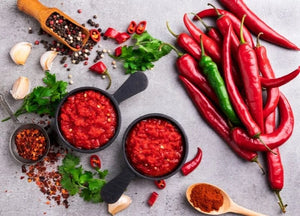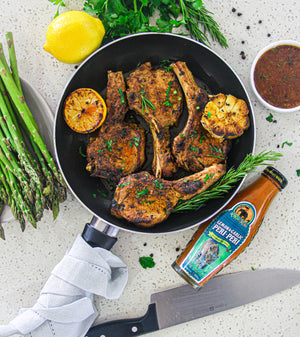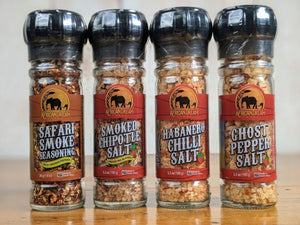The Ultimate Guide to Hot Sauce Recipes
Nov 02, 2021
Hot sauce is one of the most popular condiments in the whole world, and it has become a staple in restaurants. However, because they’re so fiery and versatile, everyone wants to know how to make hot sauces at home. Surprisingly, it’s pretty easy and cost-effective to do so.
So, continue reading to know how to make that spicy sauce at home and everything there’s to learn about its different variations.
How Do You Make Homemade Hot Sauce?
The basics of hot sauces are the same regardless of what ingredients you’ll use. You’ll mix hot peppers, vinegar, salt, and other ingredients that vary from one hot sauce recipe to another, such as citrus juice, vegetables, fruits, and choice of seasonings.


So, here’s everything that you need to make hot sauce at home as a beginner. Let’s start with the ingredients.
Peppers

Peppers are the most essential ingredient in a hot sauce recipe. One of the best things about peppers is that there are so many of them. Regardless of the culture or cuisine, you’ll find a local variety of pepper that spices up countless recipes.
Pick the right type of hot pepper according to heat level, which is categorized according to its rank on the Scoville Scale and is measured in Scoville Heat Units or SHU. The higher the units on the Scoville Scale, the hotter the pepper will be and vice versa.
For example, bell pepper is 0 SHU because it’s not spicy at all. Tabasco ranges from 100 to 5000 units, jalapeño ranges from 2500 to 8000 units, cayenne ranges from 30000 to 50000 units, Scotch Bonnet ranges from 100000 to 350000 units, and so on.
Some people also love to use dried pepper in their recipes, while others prefer powdered ones. Each choice has its own fans according to the flavors they want out of their hot sauces. However, note that adding water when using dried peppers is necessary to maintain the right consistency.
In our jalapeño hot sauce recipe, we’ll use fresh green jalapeños. They’re a good place to start.
Vinegar and Citrus Juice

Just like peppers, there’s a lot to choose from when it comes to vinegar while making hot sauce. You can use white distilled vinegar, apple cider vinegar, malt vinegar, red wine vinegar, and more. The point is you can mix and match however you want in a homemade recipe, which makes it so much fun.
Even better, you can make the hot sauce by adding citrus juice to the mix or even replacing vinegar with citrus juice altogether. Options include lemon juice and orange juice. Each choice adds a different taste so that there’s something for everyone.
In our recipe, we’ll use white vinegar.
Vegetables and Fruits

What kind of chunky bits do you want in your unique hot sauce recipes? Now, that’s a good question to ask. Veggies and fruits are crucial ingredients that can dramatically elevate your recipe beyond the beginner level.
The most common plants in hot sauces besides spicy peppers are tomatoes and carrots. They’re so versatile, and their constant availability makes them attractive and wanted in most recipes.
While veggies are considered the basics of hot sauces, fruits bring sweetness and character to the overall flavor. The most commonly used fruits are lemons, oranges, tangerines, mangoes, cherries, peaches, apples, blueberries, kiwis, dates, guavas, and pineapples.
Seasonings and Salt

Now is the part where you can experiment with seasonings and salt. There are no rules here; you can go crazy. You can incorporate garlic, onion, ginger, ginger, cumin, coriander, parsley, and even sugar or honey in your original recipes.
Equipment Needed
You’ll need rubber gloves to protect your hands. And the cutting board is essential for you to cut the peppers on. Also, you’ll use the knife to remove the excess membrane, slice, and dice. Plus, you need a saucepan for the cooking part.
The food processor/blender is a must to blend your mix. After blending, you’ll get a strainer to remove the pulp. Finally, the glass bottles, jars, or containers are for storage or serving purposes, of course.
Safety Advice
Handling hot peppers is tricky, especially if they’re super hot. So, it’s good to take a few safety measures to prevent a fun hot sauce-making experience from turning into a hot mess, no pun intended.
If that’s your first time making hot sauce, wear thick rubber gloves while cutting the hot peppers, work in a well-ventilated room, and wash your hands and equipment thoroughly after finishing.
Some people even wear goggles to protect their eyes. If your hands touch your nose or eyes before you wash them, especially if you have contact lenses, you’ll experience one of the worst burning sensations ever.
Also, after you make your hot sauce, keep it in the fridge. This isn’t only to keep it from spoiling but also to prevent it from fermenting to the point of literally exploding.
Easy Hot Sauce Recipe
MOST COMMON INGREDIENTS:
1lb Fresh green jalapeños (or your choice of chili peppers)
1/2 cup – 1 cup Vinegar or citrus juice
Choice vegetables and fruits, optional
1/2 tsp – 1 tsp Seasonings and salt
Fresh garlic, to taste
Water, Optional with fresh pepper, necessary with dried
EQUIPMENT NEEDED:
Thick rubber gloves
Cutting board
Knife
Saucepan
Food processor/blender
Strainer
Glass bottles, or containers
DIRECTIONS:
First things first, you need to wash the peppers if they’re fresh. Use the paring knife to remove all the excess membrane, then use the chef’s knife to chop off the peppers. Some people like to deseed the peppers in this step. Add the chopped-up jalapeños, vinegar, fresh garlic, salt, and water to a saucepan. Leave the ingredients to simmer for 10 to 20 minutes on medium heat so that they soften and become easier to blend later. The heat is also necessary for the flavors to blend beautifully. Check the consistency of the ingredients from time to time and add water if the ingredients become thicker than anticipated, which is common. Take the ingredients off the heat and let them cool down before you process them. Once they’re cool enough, add them to your food processor and blend them to the desired consistency. Some people blend their hot sauces until they become creamy, while others prefer to feel the chunky bits. This is where you experiment according to your personal taste. Once you’ve reached the desired consistency, strain out the pulp with the strainer and pour the mix into a glass bottle or jar for storage if you want to keep it in the fridge. You can also serve it right away with your food. Enjoy!
Fermented Hot Sauce
The difference between fermented and non-fermented fresh recipes is that fermented ones last longer and are believed to be even healthier. The most popular chili peppers that people ferment are jalapenos and habaneros.
Benefits of Fermenting Hot Sauce

There are countless benefits to hot sauce made by fermentation, but what does fermenting hot sauce even mean?
Fermentation is the decomposition of food by microorganisms, such as lactic acid bacteria, or enzymes. It’s an ancient technique of preserving food.
It’s so healthy because when you ferment food, you create an anaerobic environment that helps beneficial bacteria thrive, and bad bacteria starve.
The good bacteria, also known as probiotics, is the lactic acid in this process because it feeds on the carbohydrates and turns them into acid, which preserves the hot sauce for much longer than fresh hot sauce.
Because the lactic acid digests the carbohydrates while the hot sauce is being aged, fermented hot sauce is much easier to digest.
In addition, fermented food, including healthy hot sauce, boosts the immune system, thanks to being rich in all kinds of nutrients. The probiotics involved in fermentation have also been linked to reducing blood pressure.
It also has a deeper, more complex flavor that fresh hot sauce may lack.
How to make Fermented Hot Sauce
MOST COMMON INGREDIENTS:
1lb Destemmed Chili Peppers
1/2 cup – 1 cup Vinegar
3 Tbsp Salt
1/4 cup Water
EQUIPMENT NEEDED:
Thick rubber gloves
Cutting board
Knife
Saucepan
Food processor/blender
Strainer
Glass bottles, or containers
Mason Jar(s)
DIRECTIONS:
Pack the washed and chopped-up peppers into a mason jar, leaving at least an inch at the top of the jar because fermented peppers tend to rise. In a separate container, mix ¼ cup of water with 3 tablespoons of salt. Then, pour the brine over the peppers to ensure that they’re fully covered with it. Push them down as needed. Screw on the lid of the jar and keep it away from direct sunlight to ferment for a minimum of two weeks. The ideal temperature for fermenting hot sauce is somewhere between 55 to 75 degrees F. Monitor the jar within the two weeks to do what’s needed. For example, you may need to let out the accumulating gases. After two weeks, drain the peppers from the brine and set the brine aside. Add the peppers to a food processor/blender with ½ to 1 cup of your vinegar of choice. Pour as much of the brine as you want into the mix. Process the mix until it reaches the consistency you like. Pour the mix into your saucepan and let it simmer anywhere from 10 to 15 minutes, which will bring the fermentation to an end. You can strain the fermented hot sauce to remove the pulp or leave it as is. Pour the fermented hot sauce into the bottles, jars, or whatever kind of containers you like to store the homemade hot sauce in.
Types of Hot Sauce Around the World

There’s an abundance of styles of hot sauces all over the world. Learning about international hot sauce styles enables you to experiment with your menu by using ingredients in your kitchen that you didn’t know would make a delicious hot sauce.
These recipes use local varieties of pepper with different levels of heat, and each recipe brings an ingredient or two that another one doesn’t use at all.
North America
Louisiana Style
When it comes to hot sauces, it doesn’t get more American than that. The Southern staple utilizes fresh or fermented, traditionally red peppers mixed with white wine vinegar and salt. Americans pair it with anything, from pizza and eggs to meat marinades and stir-fry.
Buffalo Sauce
Buffalo wings make no sense without their best friend, buffalo sauce. It incorporates cayenne peppers, vinegar, garlic, and butter to create a juicy classic staple in the world of chicken wings.
Cholula
Most lovers of Mexican food are here for the spices. As a result, Cholula definitely belongs on the list. It uses some vinegar with red hot Arbol peppers or Piquin peppers, which are 5 to 8 times hotter than jalapeños, thanks to measuring at 30000 to 60000 units on the Scoville Scale.
Salsa Picante
Of course, we couldn’t mention only one style of hot Mexican sauces. Chipotle, habanero, jalapeño, and pequin chilies all play a role in this hot sauce. It has a thinner consistency than its American counterparts, as it puts a larger emphasis on peppers than anything else.
Hawaiian
Hawaiian chili pepper water is basically Hawaiian chili peppers, ginger, vinegar, garlic, and water. It’s an interesting choice for anyone who wants a thinner consistency but still a little bit of heat in their kitchen.
South America
Ají Amarillo
The most popular item in Peruvian cuisine, the Ají Amarillo paste needs the Ají Amarillo or locally available yellow chilies, garlic, olive oil, and salt. After you make the paste, you can use it as is or mix it with mayonnaise, sour cream, tomato paste, shallots, lime juice, salt, and pepper.
Pebre
Here comes the famous Chilean recipe, Pebre. It uses Ají, green, or red hot peppers. In addition, you’ll need coriander, tomatoes, onions, garlic, and cilantro. A little bit of Chile on your scrambled eggs can definitely upgrade your breakfast.
The Caribbean
Scotch Bonnet
Scotch Bonnet peppers are crucial in Jamaican cuisine. They’re full of different flavors that will make you feel like a chef in your kitchen. Besides the peppers, the recipe uses salt, vinegar, garlic, onion, lime juice, cumin, carrot, cucumber, chayote, mango, and pineapple.
Habanero
If you want a little taste of Belize, try the Belizean habanero chili sauce. What sets it apart is the reliance on carrots, along with Habanero peppers, garlic, lime juice, vinegar, salt, onion, tomatoes, and olive oil, of course.
Asia
Sriracha
The most famous sauce in Thailand and Vietnam, Sriracha, is a staple in every Asian kitchen. It’s a little bit mild because while it uses a paste of chili peppers, garlic, vinegar, and salt, it also uses sugar for a classic vinegary sweetness.
Gochujang
If you haven’t tried Korean chili sauces, you’ve been missing out. Besides chili powder and salt, it stands out with fermented soybean paste, sticky rice, and a sweetener. As a result, its viscosity and sweetness make it memorable.
The Middle East and Africa
Muhammara
The Middle Eastern spread or dip also plays on this unique hot yet sweet aspect. Muhammara is roasted red peppers, garlic, lemon juice, pomegranate molasses, toasted walnuts, breadcrumbs, cayenne, paprika, cumin, salt, pepper, and olive oil. Once you taste it, you’ll know what it means to get lost in the sauce.
Harissa
Harissa, commonly used in North African sauces, dishes, and stews, will change your kitchen once you taste it. It’s made of roasted ground red chiles, cumin, garlic, dried mint, coriander, paprika, lemon, salt, and olive oil.
Shatta
Shatta is an Egyptian sauce that you’ll commonly find in North Africa and the Middle East. It has a thicker consistency because it consists of ground chiles, olive oil, tomato paste, parsley, and coriander.
What Can You Do With Extra Hot Sauce?
You can do so much with leftover homemade hot sauces that goes beyond just using them as a condiment in your recipes.
If you want to make your burgers more interesting, you can drizzle a little bit of hot sauce on top. Hot sauces also bring life to salads, so why not add them to vinaigrettes or ranch? If you’re feeling bolder, you can use leftover chili sauce in making Mexican hot chocolate to keep you warm.
As you can see, nothing is stopping you from making your own hot sauces at home. There are basic ingredients that most people use, and you can make the rest your own.
You can serve the pepper sauce right away or even age it for a more complex taste, more health benefits, and longer shelf life. There are plenty of world recipes to take inspiration from. From Mexico to Egypt, you can bring a piece of any type of cuisine you love into your kitchen.




